While seated in the visitors dugout and holding court with the media, the Orioles uniform-adorned manager Buck Showalter is asked if he liked wearing those duds.
"No," the Orioles manager replies wryly. "Have you seen me in a uniform?"

Despite his self-deprecating humor, the 59-year-old skipper presents a more graceful look than other older or more rotund managers. Dodgers manager Tommy Lasorda still sported a uniform at 68, and so did 69-year-old Phillies manager Charlie Manuel.
"You have Jack McKeon at age 80 dressed up like a jockey," says John Thorn, Major League Baseball's official historian.
Decked out in the same MLB uniforms as their players, these figures make for a peculiar -- and unique -- sight.
In the other major sports, the coaches wear suits or sport coats (basketball and hockey) or a team logoed top and pants (football).
"We're glad we're different," Orioles reliever Tommy Hunter says. "It's a niche that baseball has."
That niche actually has a historical precedent.

During the origins of the game, the business manager -- who made travel arrangements, handled the books and ensured players received appropriate compensation -- was called the "manager." He wore street clothes.
The “captain," who typically was a uniformed player, determined the batting order, made player substitutions and pitching changes, etc. He was basically what would be later known as a player/manager.
Around 1900, according to Thorn, the term "manager" stopped referring to the business manager and began referring to the person making strategic moves, player substitutions, etc.
The original "manager" would evolve into the modern-day general manager, and the player/manager would eventually fall out of vogue. (Only six -- Hank Bauer, El Tappe, Frank Robinson, Joe Torre, Don Kessinger and Pete Rose -- have occupied the latter role since 1960.)
By the 1940s managers Connie Mack of the Philadelphia A's and Burt Shotton of the Brooklyn Dodgers wore street clothes long after their playing days had expired, but they were the exceptions.
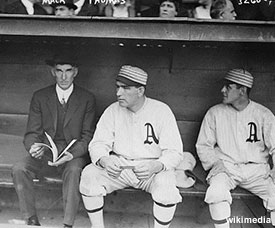
Presently, MLB’s only official rule regarding the matter is 1.11 (a) (1) and states: "All players on a team shall wear uniforms identical in color, trim and style, and all players’ uniforms shall include minimal six-inch numbers on the back."
Note that managers are never specifically referenced.
When asked about the discrepancy, MLB released this statement: "The tradition of managers and coaches wearing uniforms has long been an accepted practice and well understood, even without formal rules being in place."
MLB managers seem agreeable toward the understood rule regarding uniforms.
"It’s better than wearing a suit," White Sox manager Robin Ventura says.
But it’s also a bit perplexing, considering the clubs’ trainers wear short-sleeve polo shirts and khaki pants, and their job of working on players’ injured joints seems as physically taxing -- if not more so -- as any manager's.
"It’s a lot of work to put on the whole uniform," says Orioles All-Star closer Zach Britton, "especially for the manager when there's no need for you to go sliding or diving."
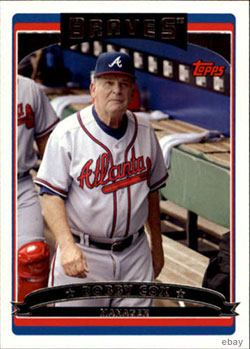
When eccentric Braves owner Ted Turner made the brazen move to manage his team for one game on May 11, 1977, he crammed a chunk of chaw in his cheek and sported jersey No. 27.
"He had never been a player, never been a coach, never worn a uniform, but for the day that he was manager, he was outfitted with a uniform," Thorn says. "That tells you something about the strength of the tradition."
Some managers dress like their players -- down to the very last detail. Showalter wears stirrups. Bobby Cox wore a cup and spikes for every game.
"You never see a manager wearing actual cleats … It was hilarious," says Adam LaRoche who played for Cox while with the Braves from 2004-2006. "It's just his style. He went from playing right into coaching and managing and never took his cleats off."
Cox, who has the most ejections in managerial history with 158, explained part of the rationale behind his shoes to Sports Illustrated: "Could you imagine going out there in shiny dress shoes?" he said. "How would you kick dirt on the umpire?"
There are other reasons why it does make sense -- as silly as it might look -- for managers to wear uniforms.
One is the weather. Baseball is the only major sport played outside in the dog days of summer when the heat can be oppressive.
"George Costanza had it right," Showalter joked, in reference to the Seinfeld episode in which he starred and Costanza lobbied the Yankees to play in cooler, more breathable cotton uniforms.
MLB players still play in polyester -- Costanza’s cotton idea backfired as the uniforms shrunk -- but that is much more comfortable on a stifling summer day than a dressy suit.
On cold days -- especially in the postseason of October -- managers often wear hooded sweatshirts. MLB allows this as long as they wear them over their jerseys, an edict that is not strictly enforced.
"How are they going to know if there's a uniform on?" Orioles shortstop J.J. Hardy says.
Unlike other leagues, particularly the NFL, which fined running back Frank Gore $10,500 for wearing his socks too low during the 2013 NFC championship game, MLB seems to take a more lax stance on attire.
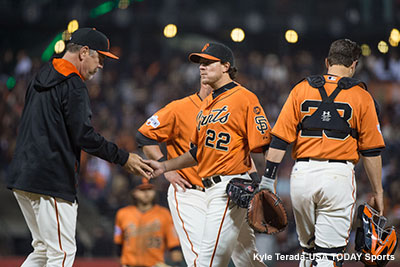
"Major League Baseball does not police all of its rules equally," Thorn says.
Regardless of the league office’s rigidity (or lack thereof), MLB managers also wear a baseball uniform because of where they operate.
When they venture out to replace a pitcher or for an in-game meeting, it often takes place near a grimy mound. Mack, who wore dress clothes during his entire 50-year A’s managerial career, didn’t typically venture onto the infield and used his scorecard to signal his players where to move.
The manager’s workspace is a gross setting littered with sunflower seeds, gum and tobacco juice and not conducive for formal attire.
“It’s too dirty in the dugout," White Sox pitcher Jeff Samardzija says. "Let's just wear clothes that we can clean."
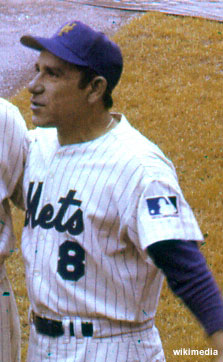
Those easily laundered baseball uniforms aren't worn over pads (like football or hockey). They also provide adequate coverage. (Imagine basketball coach Gregg Popovich donning the same sleeveless jersey and shorts of his Spurs players.)
"A basketball coach wearing a basketball uniform or a football coach wearing a football uniform would look a little weird,” said Samardzija who started at wide receiver for Notre Dame. "Of all the sports, the baseball uniform is about as close to normal clothes as possible. That’s probably why they can get away with it."
Baseball uniforms weren't always so … uniform. In the late 1800s, clubs outfitted their players in different ways.
That specifically applies to franchises in Baltimore and Chicago.
Baltimore's silk yellow shirts were so bright that they became known as the Canaries.
Each position player on the 1876 White Stockings wore a different fez-like hat to denote where they played. The Chicago Daily Tribune wrote they looked like "a Dutch bed of tulips."
In 1882 players wore different colored silk jerseys to signify their specific positions. (For example, second basemen had orange and black vertical stripes while shortstops had maroon tops.)
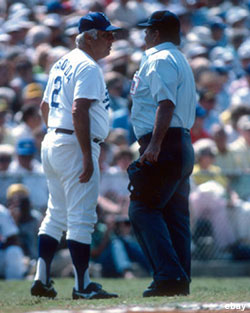
A player revolt against the ridiculousness of the garments (and the oppressive warmth of the silk) ended that experiment shortly thereafter.
Baseball introduced its first uniform rule in 1885 when the American Association stated that each club "shall be required to adopt a neat and attractive uniform for its players, and shall at all times be required to present the same upon the field in a clean and attractive condition."
Fabrics, colors and striping have changed since then, but for more than 60 years, all Major League Baseball managers have worn the exact same uniform as their players.
With history and tradition more tied to the National Pastime than any other sport, don’t look for managers’ sartorial choices to be altered now or forever.
"We don't like change," Hunter says. "So I say keep it as is."
-- Follow Jeff Fedotin on Twitter @JFedotin.





















